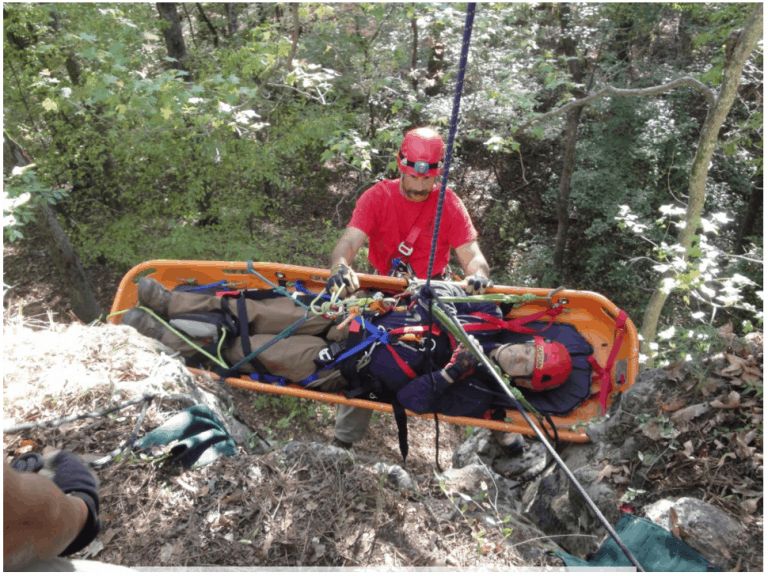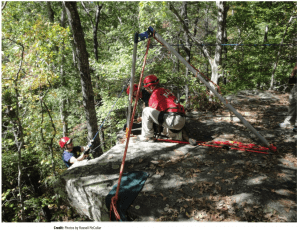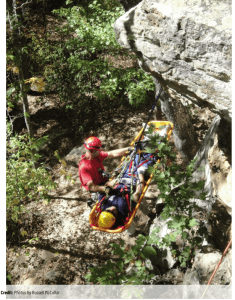(This article was originally run in Firehouse October 1, 2019)
Russell McCullar clarifies whether 15:1 is still relevant and says that fire departments should select gear and load limits that meet their needs. All Photos by Russell McCullar
Not long ago, I was explaining to one of my students that our training agency was undergoing a transition from NFPA 1983 General Use to Technical Use rope and equipment. As I outlined the benefits, merits and headaches of this transition, the student looked at me quizzically and inquired, “So, you all are moving away from 15:1 safety factors?”
I was surprised by his question. It was 2017 and this student was in his early twenties. His father is a venerable rescue and hazmat instructor who owns his own business in training and consulting with industrial customers. It served as a reminder of how much knowledge in the American fire service is handed down in the spirit of oral tradition from our officers, our mentors, and yes, even our fathers. We are so accustomed to taking people at their word, he had no idea that words such as 15:1, one-person rope, two-person rope, safety factors, and many similar such sentiments, had not been published in NFPA 1983 since before he was born.
That’s right, folks. The last time these words appeared in NFPA 1983 was in the 1995 Edition. This means that many fire rescuers reading this article have been free from these oppressive shackles their whole lives. Most people, however, do not even know this is the case. Worse yet, there are still plenty of instructors and even a handful of modern texts that still proliferate this erroneous folklore from our past. I am a student of history, and like myself, I encourage students to ravenously press their instructors and the status quo, and ask, “Why?” But in order to appreciate the present, and prepare for the future, it is paramount that our rescue community understand and appreciate the past evolutions and advancement of our craft.
The current 2017 Edition of NFPA 1983 contains three main categories of life safety rope and equipment. These are Escape Use, Technical Use and General Use. General Use rope and carabiners (connectors) still have a minimum breaking strength (MBS) of 40 kN/9,000 lbf. Technical Use rope is still 20 kN/4,500 lbf and Technical Use carabiners are now 22 kN/4,950 lbf. I have elected to use approximations for simplicity. Readers can dig much deeper into the new versions of 1983 and examine subtle differences in requirements for pulleys, auxiliary equipment, descent control devices and belay devices. The first edition of NFPA 1983 from 1985 has grown from five pages of material to the now 90 pages of content.
The most important takeaway is the fact that there are no prescribed ratios or loads. You, my friends and colleagues, are the Authority Having Jurisdiction. 1983 just informs manufacturers how strong to create and design the equipment, how to test it and how to label it. Your team and your department get to do the homework and select the gear and load limits that meet your needs. In the eyes of this document, there are no imposed limits on the loads you use with Technical Use gear. The NFPA does not impose a safety factor on your equipment or team’s systems. A one-person load has no set value. Your team is responsible for setting this value.
History of NFPA 1983
Some readers may not be aware, but the modern age of technical rescue began on June 27, 1980 when FDNY firefighters Larry Fitzpatrick and Gerald Frisby fell to their deaths. Frisby became trapped at a 7th-story window of a working fire. Fitzpatrick was lowered from the roof on a 150-foot nylon “roof rope” to rescue Frisby. When the system was weighted by both men, the line cut and both fell to their deaths. While some parts of this incident are still debated, what is certain is that it would serve as an awakening and revolution in not only rescue ropes and equipment, but the rescue community as a whole.
Subsequent to this incident, in 1981 the IAFF published a white paper entitled Line to Safety. It is within this widely distributed opinion paper that the groundwork for the first edition of NFPA 1983 would be laid. In the opening, it is stated that a 7:1 or 10:1 safety factor is adequate for a safe working load in industry, but is “inadequate for critical rescue use.” It is here that a two-person load is stated to be 600 lbs and a 15:1 safety factor should be applied to the rope, necessitating an MBS of at least 9,000 lbs. It should be noted, at the time, ropes had to be larger than ½-inch in order to meet this requirement. The paper mentions 5/8 inch–¾ inch in diameter rope examples. A final bit of trivia about Line to Safety is that in the references, it endorsed two then-unknown-to-rescue manufacturers—Pigeon Mountain Industries (PMI) and Bluewater. This thrust these two caving/climbing rope companies into the professional rescue scene in a big way.
The major tenets of Line to Safety would be echoed in the first version of NFPA 1983 that became available in June of 1985. This document would define one and two-person loads as 300 and 600 lbs, respectively. It also designated rope and equipment as one-person and two-person. Maximum working loads were expressed in pounds by dividing the MBS of a new rope by a factor of not less than 15. Finally, one last fan favorite in the first edition of 1983 was that life-safety rescue equipment was one-time-only use and had to be retired after use in an actual rescue.
At this point, you should be asking yourself “Why?” If you think about it, it really makes sense. At the time, there was very little in the way of research or empirical testing in rescue rope, equipment and methods. There were few subject matter experts who actually carried credibility in fire-rescue circles. Most were from the climbing and caving communities and their respective rescue circles. The techniques and equipment being used by fire departments for vertical rescue came directly from cavers and climbers. This included caving kernmantle rope, the Cole Rack and the Anderson figure-of-eight descender. As it were, the founders of two prolific rescue rope and equipment companies that remain today lobbied hard in the early days to lower the strength requirements and strict language.
In the eyes of the fire service, the IAFF and 1983 committee members of the time, the rope and equipment should be over-engineered to mitigate both the unknown and the foreseeable abuse and misuse of rescuers. Little was known about the effects shock loading, the degradation of nylon and polyester over time, and an infinite number of “what if … ?” in rope and rescue. Contrast that to present day, there is an endless library of testing and data if you know who to ask and where to look. This is largely thanks to the International Technical Rescue Symposium, formerly NATRS. The first symposium took place in 1985 and served as a venue for rescuers to present on anything from laboratory to “backyard testing” in rescue. This included slow-pull testing, drop testing, the infamous belay tests, and even what really happens to your rope when it is urinated upon. Much of this data can be accessed online and has been published in other academic and periodical venues.
The events of June 27, 1980 and subsequent papers and standards effectively “professionalized” rescue in North America. Over the next decade, at NATRS, in texts, articles, fire halls, and even bars, the best tools and techniques for rescue would be tested, argued over and scratched out on napkins, as an informal body of knowledge of best practices would be baptized under fire. Ultimately, this would result in inventors and manufacturers responding to rescuer needs and bringing equipment to market designed specifically for professional technical rescue. Kirk Mauthner and Traverse Rescue would bring the 540 Belay to market in the mid 1990s and by the turn of the millennium, Petzl would introduce the Industrial Descender (I’D). In present day, the market and demand for this gear is insatiable. Groundbreaking advances that once were years apart are now occurring every few months.
Postmodern era in technical rescue
The current trend is a great advancement of technology and equipment. Much more than the 1980s and 1990s, the rescue community is seen as a market to make profits. Everywhere you turn is another rope rescue instructor with an upstart training company. Twenty years ago, there were less than a dozen pieces of specialized rescue equipment specifically engineered for our needs. Today there are over a dozen devices from different manufacturers that are analogous to the Petzl I’D.
Incredible innovations are made by international companies just as often as they are by intrepid engineers in garages with 3D printers. One of the problems as a trainer that I do not relish tackling is really having to pick the best device or platform to teach rescuers across an entire state. What brands or devices do I bring into my personal rescue philosophy? In the 1990s a rack was like air and water—had to have it. In the 2000s it may have been the I’D. In the 2010s it could arguably be the CMC MPD. The field is more blurred as the years pass. I hate the idea of wholly aligning a curriculum with one product.
TTRS vs. STM/UTB
Another aspect that must be addressed is single tensioned mainline (STM) and un-tensioned belay (UTB) versus two tensioned rope systems (TTRS). Researchers like Mauthner and myself almost definitively proved the efficacy of TTRS versus UTB. In short, the benefits include the integrity of the rope and sheath from edge damage.
Additionally, fall distances and impact forces are greatly reduced. The problem with TTRS is that most descent control device configurations in a lowering setup rely too heavily on human reaction time. When lowering with a TTRS using I’Ds, MPDs, and similar, when one line is cut away, the operator of the surviving line often demonstrates a momentary delayed reaction. This results in an unacceptable fall distance or even ground impact.
Mauthner’s solution involves additional rescuers “tailing” the ropes. This requires throwing extra staffing at the problem. I see this more as an engineering problem. Manufacturers should give us a device that is sized like an I’D, works like an MPD, and has auto-stop properties of the Petzl ASAP.
Despite the obvious advantages, the jury is still out in other areas of TTRS. There are competing schools of thought on how they are managed in Artificial High Directional (AHDs). Both high have problems. One high, one low has its own problems. Some theses only work if the assumption can be made that the AHD is bomb-proof. Most believe the edge transition to be the most precarious time, but it is often difficult to maintain dual tension during many edge transition scenarios. As a community, we know we want to live in a world of TTRS, but there are pieces to the puzzle that have not been definitively addressed.
Force-limiting systems and devices
One of the greatest paradigm shifts that directly relates back to safety factors is the concept of force limiting. This concept was proliferated largely by Mauthner, Lt. DJ Walker and myself during the International Technical Rescue Symposium in 2014. Basically, the market has brought rescuers all manner of devices that will slip at reasonably predictable values without damaging the rope. This means many systems can be rigged with a device that can be likened to a fuse, pressure relief valve or shock pack. Prusiks were erroneously portrayed as force limiting through the 1980s and 1990s, but were anything but predictable. The MPD, I’D, Gri Gri, D4 and similar devices are all capable of this force limiting behavior. So why does that matter? It means things will not break or explode as believed in the 15:1 days. Rather, they will slip when over-tensioned or strained. Thus, the death moans of the old Kootenay Highline and all the Prusik bypasses and load release hitches to boot! Now that is exciting. Highline recipe: 1. Far side—tensionless anchor or knotted termination. 2. Nearside—MPD or I’D Z-Rig. First trackline done. Need more support or elevation? Repeat steps one and two until satisfied.Where we’ve been and where we’re going
Where we’ve been and where we’re going
The last 10 years of “sexy” rope training in niche schools has been highlighted by rigging and AHD work that takes hours before the first line is loaded. Photos of such courses flood social media. I love this stuff and enjoy it with the best of them. But rigging for art’s sake does not the best rescuer make. Recent and future years have, and should have, a renewed emphasis on personal on-rope skills. This means true rope ascending, changeovers, controlled descent and negotiating obstacles. Rope access techniques and technical rescue in the fire service will continue to merge. It should not require a $400 piece of kit to perform a standard pick-off. With typical climbing system, carabiners and a soft link, most rescuers should be able to facilitate most one-on-one rescues.
Additionally, the proliferation of automatic back-up devices will replace the need for a dedicated belay operator. This will save a unit of staffing. This enables faster patient access, faster rescues and better empowers rescuers to maneuver and self-rescue. In every discipline, a return to original roots happens periodically. It gives me great satisfaction to conclude that 15:1 is not really very important anymore. It is real and part of our rescue history—our early foundations and identity. As a rescue community, it is important to remember who we are and where we came from. Now is the time for our community to look forward and solve more difficult problems. The cliché arguments about absolute breaking strength and two-person loads is so 1995. The present-day is one of force-limiting systems rather than absolute catastrophic failure, advancing our personal on-rope rescue craft, selecting the right tools from many options and troubleshooting new paradigms like TTRS.
[thrive_lead_lock id=’51985′]Hidden Content[/thrive_lead_lock]
References
Mauthner, K.(Producer). (2014). Does evidence support an un-tensioned back-up(belay)? [Digital Video]. Golden, CO: International Technical Rescue Symposium. Retrieved from: https://www.youtube.com/watch?v=-43yf8SDs4M
Mauthner, K. (2016). EMBC Rope Rescue NIF Equipment Testing Summary Report. Invermere, BC.
McCullar, J. (2015). An Analysis of Traditional and Two Tensioned Rope Systems. Portland, OR: International Technical Rescue Symposium. Retrieved from: http://itrsonline.org/two-tensioned-rope-systems/
McCullar, J., Walker, DJ. (2014). Slow Pull Testing of Progress Capture Devices. Denver, CO: International Technical Rescue Symposium. Retrieved from: http://itrsonline.org/slow-pull-testing-of-progress-capture-devices/












9 thoughts on “Technical Rescue: The Importance of 15:1”
802401 745710Wow, fantastic weblog structure! How long have you ever been running a blog for? 203658
This is great article! Thank you 🙂
744581 299521Some genuinely rattling function on behalf of the owner of this internet site , utterly wonderful content material . 938815
711150 895013Thanks for the post. I like your writing style – Im trying to start a blog myself, I think I may well read thru all your posts for some suggestions! Thanks once a lot more. 544299
Im no longer positive where you’re getting your information, however good topic. I needs to spend a while learning more or working out more. Thank you for fantastic information I was in search of this info for my mission.
I have recently started a site, the information you provide on this website has helped me tremendously. Thanks for all of your time & work.
259433 11176Sweet web site , super pattern , rattling clean and use friendly . 139003
I like this blog very much, Its a very nice office to read and get information. “There is no exercise better for the heart than reaching down and lifting people up.” by John Andrew Holmes.
Thank you for sharing superb informations. Your web-site is very cool. I am impressed by the details that you have on this site. It reveals how nicely you understand this subject. Bookmarked this website page, will come back for extra articles. You, my friend, ROCK! I found just the information I already searched everywhere and simply couldn’t come across. What an ideal web-site.
Comments are closed.